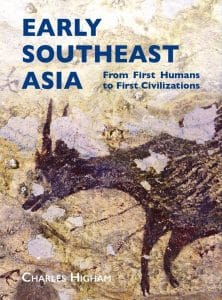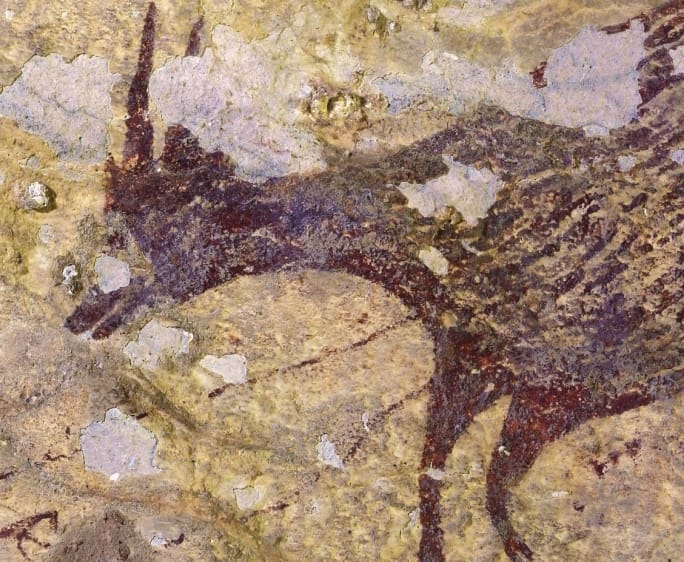Quite a lot of archaeological water, to say nothing of history writing, has flowed under the bridge since Early Southeast Asia’s first edition in 2014. Charles Higham begins this new edition with:
Exploring what happened in prehistoric Southeast Asia is still a relatively new endeavour, and with each fresh discovery, it is necessary to revisit our interpretations. Old models founder as new ones emerge in a constant process of improvement. The recent tsunami of new analytical tools, new excavations and resulting insights has encouraged me to return to my earlier synthesis and weave into it the new information that is there at virtually every turn.

This likely remains the book for archaeology junkies, filled as it is with details on innumerable individual sites and excavations, charts, graphs, stratigraphy, geographical distributions, photos of artifacts in situ, maps, etc. It covers the period of the earliest humans in the region—Homo erectus, a million or more years ago, including periods when Southeast Asia formed, due to lower sea levels, single landmass known as Sundaland—through 15th-century Angkor, by which time the “early” of the title seems distinctly relative.
Higham dives deep into the weeds, which can make the book a challenging read. Yet there are a couple of clear throughlines, a (for me at any rate) mystery or two, and several interesting details.
One of these throughlines is the clear identification of Southeast Asia as a place which hangs together as a region, rather than as a mere geographical designation or as a place distinguished solely by being neither quite China nor India, something mirrored in such recent books as The Story of Southeast Asia by Eric Thompson, Maritime Southeast Asia: History, Culture and Religion; c First Century CE–Fifteenth Century CE, edited by Birendra Nath Prasad and Sea Nomads of Southeast Asia From the Past to the Present, edited by Bérénice Bellina, Roger Blench and Jean-Christophe Galipaud. Higham pushes this concept way back into the past. Indeed, in the far distant past, there is evidence of both Denisovians and the the unique and curious Homo floresiensis, a diminutive archaic human that, together with an apparently similar species remains of which have been found in the Philippines, may have survived to co-exist which so-called Anatomically Modern Humans (“us”, in other words).
The latter themselves arrived in Southeast Asia much earlier than originally supposed. Cave paintings in Indonesia predate their counterparts in Europe, giving Southeast Asia possible bragging rights for the earliest representational artwork.
Early Southeast Asia’s coverage of the bronze age is particularly interesting since most other regional histories get up to speed somewhat later. Bronze came relatively late to the region: Higham traces it from the west, passing through Central Asia to China and thence to Southeast Asia. Curiously, the use, and indeed local manufacture, of bronze seems not, at least in Higham’s telling, to have been accompanied by major urbanisation.
The major mystery, one touched upon in the other volumes, is that “history” (like, perhaps, urbanization) seems thin until rather late. The few extant records, even well into the first millennium CE, largely derive from outside sources, such as the Chinese. There is evidence of historical writing, on inscriptions, a few coins, but it remains rare: we know less about the rulers of first millennium Southeast Asia than we do about the Maya of the same period. This is less immediately noticeable in Early Southeast Asia than in some other volumes, since Higham’s cut through the material is more archaeological than historical, but it nevertheless seems curious: one assumes that there were extensive written materials but they have, on the whole, perished.
Although the book is granular and dense, Higham ties it all together in a succinct and clear conclusion, which includes some conclusions which seem to challenge at least some conventional wisdom.
Beyond the Chinese sphere of influence, the Eurocentric notion of “Indianisation” held sway until the results of prehistoric research and a closer scrutiny of the documentary evidence determined otherwise. Certainly, local elites chose to worship Indian gods, adopt certain Indian architectural forms and take Sanskrit names. Research over the last 25 years has seriously modified the extent to which Southeast Asian states were indebted to Indian inspiration.
Early Southeast Asia is not the first book one should read about the early history of the region. Hiroto Kawabata’s Lost in Evolution: Exploring Humanity’s Path in Asia is a chatty introduction to the earliest humanoids and Eric Thompson provides a readable survey in The Story of Southeast Asia. But Higham literally gets his hands dirty and provides an excellent overview of both the state of play as well as the process by which archaeologists reach their (always revisable) conclusions.


You must be logged in to post a comment.